
The Cessna 208 Caravan is a utility aircraft produced by Cessna. The project was commenced on November 20, 1981, and the prototype first flew on December 9, 1982. The production model was certified by the FAA in October 1984 and its Cargomaster freighter variant was developed for FedEx. The 4 ft (1.2 m) longer 208B Super Cargomaster first flew in 1986 and was developed into the passenger 208B Grand Caravan.

The Dassault Mirage F1 is a French fighter and attack aircraft designed and manufactured by Dassault Aviation. It was developed as a successor to the popular Mirage III family.
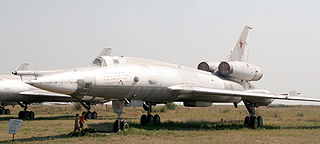
The Tupolev Tu-22 was the first supersonic bomber to enter production in the Soviet Union. Manufactured by Tupolev, the Tu-22 entered service with Long-Range Aviation and Soviet Naval Aviation in the 1960s.

The Hawker Sea Fury is a British fighter aircraft designed and manufactured by Hawker Aircraft. It was the last propeller-driven fighter to serve with the Royal Navy and one of the fastest production single reciprocating engine aircraft ever built. Developed during the Second World War, the Sea Fury entered service two years after the war ended. It proved to be a popular aircraft with a number of overseas militaries and was used during the Korean War in the early 1950s, and by the Cuban air force during the 1961 Bay of Pigs Invasion.

The Iraqi Air Force is the aerial warfare service branch of the Iraqi Armed Forces. It is responsible for the defense of Iraqi airspace as well as the policing of its international borders. The IQAF also acts as a support force for the Iraqi Navy and the Iraqi Army, which allows Iraq to rapidly deploy its military. It is headquartered in Baghdad; the current commander is Gen. Shihab Jahid Ali.

The Northrop A-17, also known as the Northrop Model 8, a development of the Northrop Gamma 2F model, was a two-seat, single-engine, monoplane, attack bomber built in 1935 by the Northrop Corporation for the United States Army Air Corps. When in British Commonwealth service during World War II, the A-17 was called Nomad.

The Chadian Air Force is the aviation branch of the Chad National Army. It was formed in 1961 as the Chadian National Flight/Squadron.

The AMD Alarus CH2000 is a two-seat, fixed tricycle gear general aviation airplane, used primarily for flight training, that was designed by Chris Heintz. It is manufactured by Aircraft Manufacturing and Design Co. in Eastman, Georgia. It is a low-wing aircraft, with one door located above each wing, respectively. It can be considered a competitor to similar aircraft used for flight training, such as the Diamond DA20.
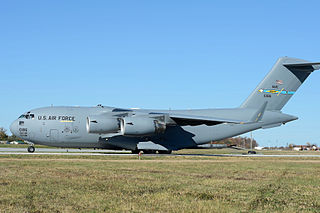
The 3rd Airlift Squadron is an active unit of the United States Air Force, assigned to the 436th Airlift Wing, Air Mobility Command. It is based at Dover Air Force Base near Dover, Delaware. The squadron operates Boeing C-17 Globemaster III aircraft supporting the United States Air Force global reach mission worldwide.
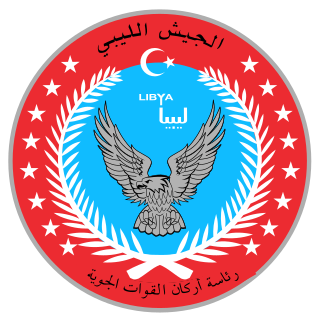
The Libyan Air Force is the branch of the Libyan Armed Forces responsible for aerial warfare. In 2010, before the Libyan Civil War, the Libyan Air Force personnel strength was estimated at 18,000, with an inventory of 374 combat-capable aircraft operating from 13 military airbases in Libya. Since the 2011 civil war and the ongoing conflict, multiple factions fighting in Libya are in possession of military aircraft. As of 2019 the Libyan Air Force is nominally under the control of the internationally recognised Government of National Accord in Tripoli, though the rival Libyan National Army of Marshal Khalifa Haftar also has a significant air force. In 2021, the air force is under command of the new President of Libya, Mohamed al-Menfi that replaced Fayez al-Sarraj.
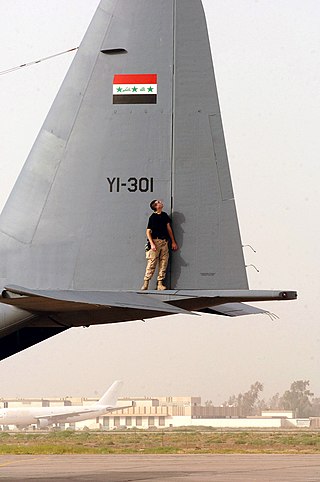
The 23rd Squadron of the Iraqi Air Force is an air transport squadron operating the Lockheed C-130 Hercules.
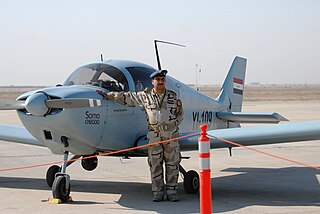
The 70th Squadron is one of the two reconnaissance squadrons of the Iraqi Air Force. As of 2016, it was based at Ali Air Base. The other reconnaissance unit is the 3rd Squadron based at Kirkuk Air Base.
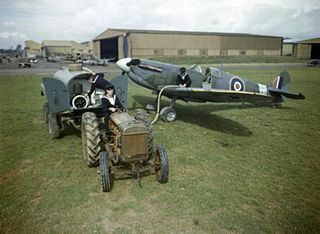
761 Naval Air Squadron was a Naval Air Squadron of the Royal Navy's Fleet Air Arm. It was formed at HMS Heron, RNAS Yeovilton, as the Advanced Training Squadron of the Fleet Fighter School, in 1941. The squadron moved to HMS Dipper, RNAS Henstridge, in 1943, as part of the No. 2 Naval Air Fighter School. It remained at HMS Dipper and in this role, until January 1946, when the squadron disbanded.
The 109th Attack Squadron is an Iraqi Air Force ground-attack squadron. It operates the Sukhoi Su-25 from Al Rasheed Air Base.
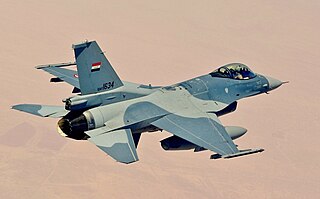
The 9th (Fighter) Squadron is a squadron of the Iraqi Air Force.

















